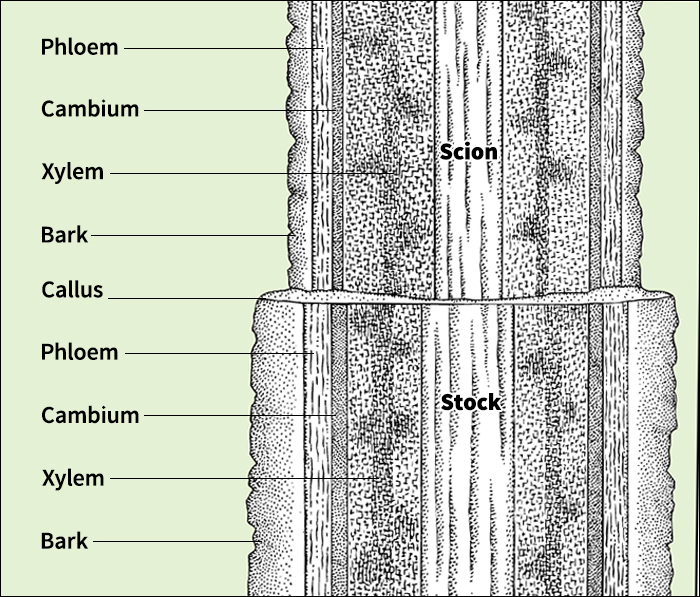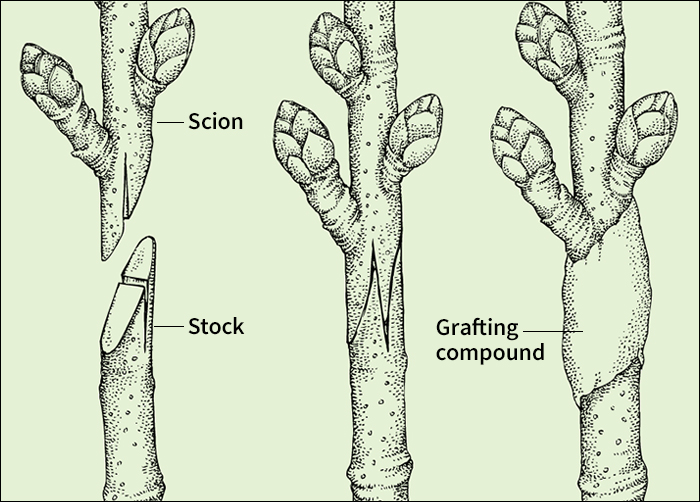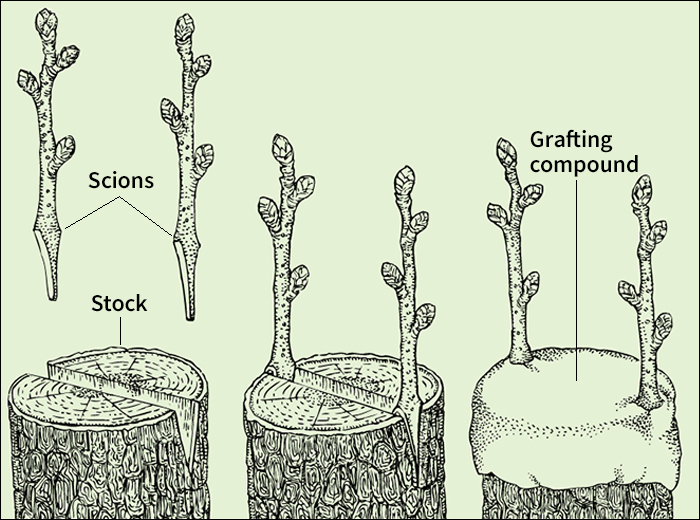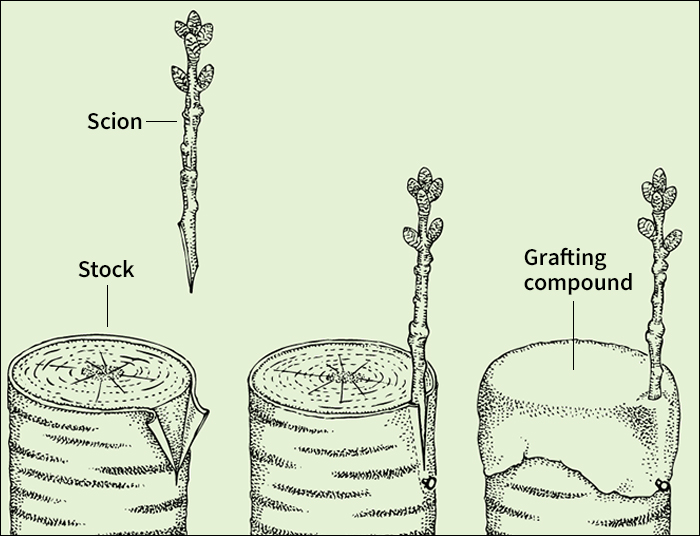Grafting is the process of uniting parts of two plants to form a single plant. Plant growers reproduce many trees and bushes by means of grafting. They also use grafting to improve and repair plants.
Grafting requires two plant pieces: a scion << SY uhn >> and a stock. The scion consists of a bud, branch, or cutting from a stem. The stock, or rootstock, is the piece to which the scion is grafted. The stock provides the root system and may also include part of a stem. For grafting to be successful, the scion and the stock should belong to the same species or to species that are closely related. Each part contributes its own characteristics to the graft. The scion determines the kind and quality of fruit, nut, or flower that will be produced by the grafted plant. The stock nourishes the grafted plant and affects its size and productivity.

Uses of grafting
The primary use of grafting is to propagate (reproduce) existing varieties of plants. Most fruit trees, including nut trees, are propagated by grafting. Grapevines and rose bushes may also be grafted. In addition, rare varieties of such flowers as magnolias, dahlias, and peonies may be propagated by grafting.
Grafting can propagate hybrids, which do not grow true to variety if raised from seed. For example, seeds from McIntosh apples almost never produce trees with typical McIntosh fruit. However, a McIntosh scion will produce apples with the same characteristics as its parent. Grafting can also propagate seedless fruit, such as navel oranges and seedless grapefruit.
Grafting can be used to change the variety of fruit a plant produces. For example, a grower can graft different apple scions to one stock and thus make a single tree bear many kinds of apples. However, grafting does not create new kinds of fruit or flowers, even when the scion and stock belong to different species. For example, a Bartlett pear scion grafted to quince stock will produce Bartlett pears.
Grafting can change a plant’s growing habits. A graft that uses established roots as the stock saves growing time. Orange and lemon trees, among others, not only grow faster but also bear fruit earlier when they have been grafted.
Grafting can also produce hardier, disease-resistant plants. Stocks that grow in poor soils or survive low temperatures can support scions that suffer under those conditions. Pear varieties that are attacked by a disease called fire blight can be grafted to quince stock to reduce the chance of infection.
Grafting can change the shape or size of a plant. For example, vigorous scions grafted to less vigorous roots will produce dwarfs. Dwarf trees bear fruit sooner than standard trees and are easier to care for and harvest because of their smaller size. Plant growers also use grafting to repair injured parts of trees. For example, scions can be grafted in place of broken branches.
Kinds of grafting
Commonly used grafting methods include whip grafting, cleft grafting, and bark grafting. In all methods, the cambium of the scion and the stock must touch. The cambium is a thin layer of growing tissue between the bark and the woody part of the plant.
Scion and stock unite as new cells grow from their cambium. While these cells form, the scion and stock must remain firmly in place. Plant grafters wrap most graft joints with tape or rubber bands, or they use a nail to hold the graft in place. For a successful graft, the plant tissues must not dry out. If grafters cut scions more than a day before they use them, they should keep the scions cold and moist. After joining the scion and stock, the grafter spreads a preparation called grafting compound over the joint to prevent drying.
Whip grafting
is used when the scion and stock have about the same diameter. To make a whip graft, cut scions in winter and graft them as soon as possible. Slice off the bottom of the scion and the top of the stock on a slant. Make a slit about 1/2 inch (1.3 centimeters) deep in each piece. The projecting tongue on one piece should fit snugly into the slit on the other, with the cambium meeting. Tie the joint and cover it with grafting compound. When the scion begins to grow after about a month, cut away the tying materials.

Cleft grafting
is used when the scion has a smaller diameter than the stock. Perform this kind of grafting in late winter or early spring. First, saw the stock straight across. Then split the sawed-off stock across the center to a depth of a few inches or centimeters. Smooth the surface with a sharp knife. Trim two scions to a wedge shape at the bottom. On each side of the split or cleft, insert a scion so that its cambium touches the cambium of the stock. Spread grafting compound over the exposed surfaces.

Bark grafting
takes place in spring when the stock begins to grow and the bark peels more easily. Cut several scions in winter and store them until spring. When ready to graft, saw the stock straight across and peel back its bark in several places just enough to make room for a scion. Pare the bottom of each scion diagonally for about 11/4 inches (3.2 centimeters) on one side and about 1/2 inch (1.3 centimeters) on the opposite side. Insert each piece between the bark and wood of the stock with its long cut against the wood. Drive a nail through the bark and bottom of the scion and into the wood. Cover the graft with grafting compound.

Other kinds of grafting
include bud grafting, bridge grafting, and inarching. Bud grafting, or budding, uses a bud rather than a stem cutting for a scion. The grafter makes a T-shaped cut in the bark of the stock to receive the bud. The bark is peeled back and the bud inserted and pressed down into the cut. Bridge grafting repairs injuries in which large sections of bark have been destroyed. Scions are joined to the stock above and below the damaged area. Inarching involves the grafting of two complete plants side by side. The grafter removes a small area of bark on each plant and ties the two together. After the plants have joined, the root and lower stem of one is cut away.
See also Pear (Raising pears); Quince.
